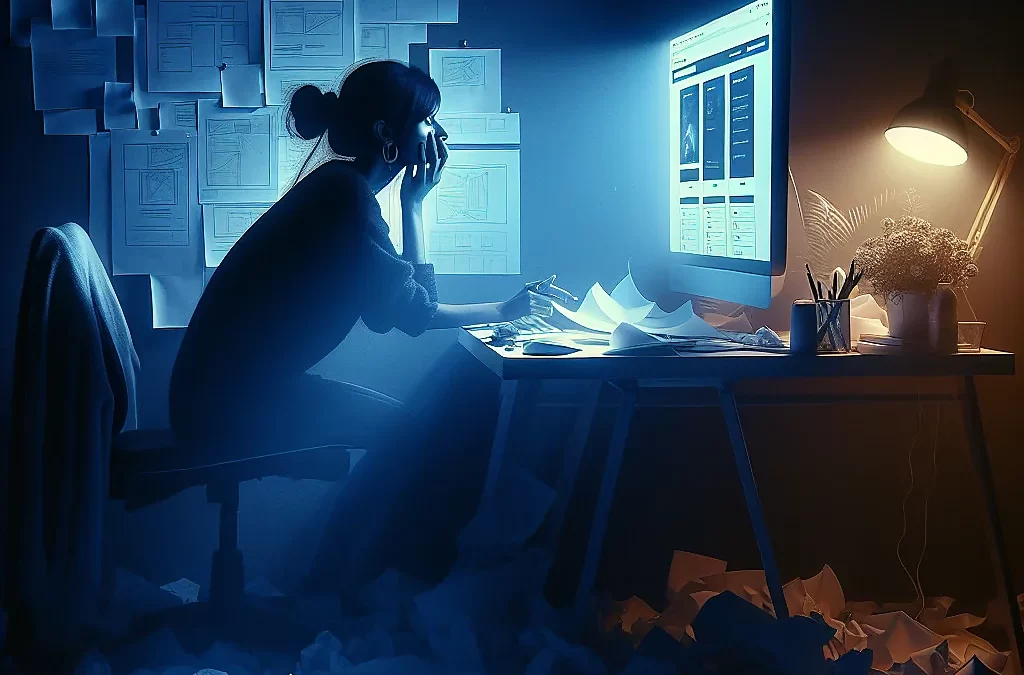The Night I Realized Simple Design Is Brave Design
There’s this one night I keep thinking about.
It was 2:13 a.m., and I was hunched over my laptop, lights off, face lit blue by the screen like some kind of late-night digital ghost.
I was obsessing—again—over a homepage I’d been designing for days. Every time I thought it was finished, I’d find one more thing to add:
- One more “cool” feature
- A hover animation
- A floating button
- A section that faded in with a gentle swoosh as you scrolled
I remember sitting back and looking at it, this Frankenstein of trendy effects and colors, and feeling… off.
Like it was trying way too hard.
Like I was trying way too hard.
And I was.
The Moment Everything Changed
I didn’t know it at the time, but that moment—that quiet dissatisfaction—was the start of something important.
When you’re early in something, especially something like web design where there’s so much to learn, it’s easy to fall into the trap of more:
More features.
More flair.
More proof that you know what you’re doing.
I’d scroll through award-winning sites and feel this heat in my chest:
I need to build stuff like that.
Things that move and flash and impress.
Then the client would come back and say something like:
“Hey, the site’s a bit slow.”
“I couldn’t find the contact button.”
“My customer said it’s too complicated.”
Gut punch.
When Complexity Becomes Insecurity
At first, I got defensive.
“They just don’t get it,” I told myself.
“This is modern design. This is elegant.”
But I didn’t fully believe that.
Because deep down, I was already starting to notice a pattern:
- The simpler sites worked better.
- They loaded faster.
- They felt calmer.
- People stayed longer.
- They clicked the thing you wanted them to click.
They sent the message. Booked the call. Bought the thing.
The simpler sites—less shiny, more focused—were actually doing their job.
Designing for People, Not Just for Portfolio
It’s funny, isn’t it?
We spend so much time trying to show what we can do, that we forget what the site is supposed to do.
I think there’s a kind of insecurity baked into complexity.
At least there was for me.
If I could make something that looked advanced, I could prove that I belonged in this space. That I had skills. That I knew what I was doing.
But the people I was building for—small business owners, solopreneurs, people with ten tabs open and a to-do list a mile long—they didn’t care about clever.
They cared about clarity.
The Moment with Raymond
There was one guy—let’s call him Raymond—who ran a small accounting firm.
I designed his site with lots of soft movement, transitions between each section, a sticky top nav that morphed colors as you scrolled. I was proud of it.
Then I watched him use it.
- He squinted.
- He hovered.
- He paused.
Then he said:
“So where’s the part where they book a call?”
Right. The button was there, technically.
But not really. Not where it needed to be.
I went home that day feeling kind of small.
Not because I had done something “wrong,” exactly. But because I realized:
I was designing for myself—not for him, or his customers.
The Simple Truth That Took Time
It’s weird how long it takes for a simple truth to really sink in.
Simple designs load faster.
Simple designs convert better.
That sounds so straightforward. Like something you’d see on a UX blog or in a YouTube tutorial.
But living that truth—earning it—took a bunch of quiet mistakes and small humblings.
Took me getting over the idea that good design needs to be flashy.
Took me seeing that restraint is often more powerful than excess.
Simplicity Isn’t Easy
That’s the irony.
Anyone who’s tried to design a clean, intuitive homepage knows it’s actually way harder than it looks.
- You have to make decisions. Real ones.
- You have to strip away everything that doesn’t serve the goal—even if it looks beautiful or took you hours.
- You have to be honest about what matters and what’s noise.
And that honesty… that’s where it gets real.
Sometimes I open up old projects and wince.
“What was I doing?”
Other times, I catch myself mid-design, adding one more box, one more section—and I stop.
I ask:
“Is this helping? Or am I just filling space?”
That pause, that question… that’s been the shift.
What I’m Learning (Still)
I wish I could say I’ve mastered it. That I always build with clarity first.
But I don’t.
I still slip.
I still get drawn into the pull of “more.”
But now there’s this voice in the back of my mind—
The one that remembers Raymond squinting, the late nights of confusion, the click maps that showed users bouncing before they even saw the offer.
And that voice reminds me:
Simple isn’t boring. It’s brave.
Simple trusts the content.
Simple respects the user.
Simple gets out of the way.
That’s the kind of designer I want to become.
Final Thought: Let Your Site Whisper What Matters
So yeah, I’m still learning. Still stumbling into the edges of my own overthinking.
But if you’re reading this and you’re in your own early days, just know this:
It’s okay to want to prove yourself. We all do.
But the real magic doesn’t come from showing off.
It comes from stripping back.
From making things that work—quietly, clearly, and without a need to shout.
The internet’s loud enough already.
Let your site whisper what matters.

